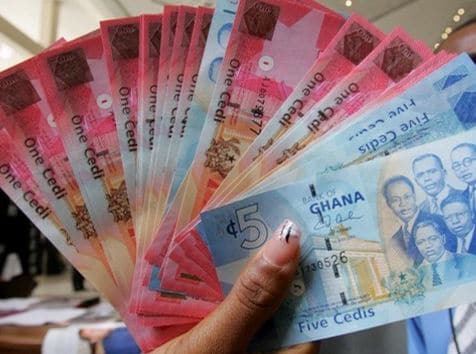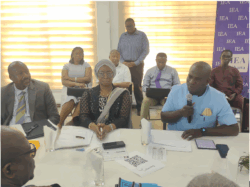The role of microfinance institutions (MFIs) in the edifice of the Ghanaian financial sub-sector; and their contribution to socio-economic development and growth of the country cannot be overemphasised. In recent years, the Ghanaian economy has witnessed the formal establishment of several microfinance institutions. Connoisseurs of activities in the financial sub-sector believe the introduction of microfinance institutions is timely to fill the lending void created in the financial industry ostensibly by universal banks and other deposit-taking institutions.
That is, the presence of microfinance institutions allows individuals, small- and medium size enterprises (SMEs) to access loans for sustainable operations, development and growth of their respective businesses; and to contribute their quota to the growth of the Ghanaian economy. This affirms the valuable role of microfinance services in developing and emerging free market economies such as Ghana.
In Ghana, microfinance businesses witnessed significant growth in the early 2000s. Their operations helped to increase the Ghanaian banked population; they had more outlets than the main stream universal banks; and had an estimated client size of 8 million (World Bank, 2016). However, the proliferation resulted in the emergence of many new unregulated microfinance service providers. The activities of these unregulated MFIs had an adverse impact on the financial system; the latter was disrupted by the former in that, operations of the unregulated MFIs resulted in loss of savings by low-income households; and high incidence of fraud and insolvency. To stem the tide, guidelines were issued by the Bank of Ghana (BoG) in 2011 for all MFIs to be brought under a consistent regulatory framework (World Bank, 2016).
Licencing and Legal Framework
After their incorporation, microfinance institutions acquire provisional licence required for their operations from the Bank of Ghana. The provisionally-licenced microfinance institutions are subsequently issued with a perpetual licence by the Bank of Ghana to fully authenticate their operations in the country. Further, effective and efficient microfinance institutions are required to be active members of the Ghana Association of Microfinance Companies (GAMC).
In consonance with trends emerging in many economies across the globe, the legal framework for regulating microfinance institutions in Ghana takes a tiered approach. The World Bank (2016) described the Bank of Ghana’s initiative as consistent with trends emerging in the international financial community. Activities of Specialised Deposit-taking Institutions (SDIs) including MFIs are categorised into four (4) tiers. Tier One englobes the activities of Rural and Community Banks (RCBs) and Savings and Loans Companies (S&LCs). Tier two comprises Microfinance Companies (MFCs) and Credit Unions (CUs). The former is a relatively new category introduced by the Bank of Ghana to ensure new businesses engaging in micro finance services are adequately accommodated, regulated, and supervised to ensure efficiency and effectiveness in their service delivery to customers. The activities of Credit Unions are primarily supervised by their parent association that is, the Ghana Co-Operatives Credit Unions Association while MFCs are supervised by the BoG.
Money Lending Companies (MLCs) and Financial Non-Governmental Organisations (FNGOs) are found in Tier Three. The former is a new designation for businesses engaged in lending while the latter refers to organisations that were instrumental in the introduction of modern microfinance methodologies in the 1990s. In principle, tier three institutions are non-deposit-taking. However, they may take and hold compulsory savings as security against loans contracted to clients. The extent of supervision by the Bank of Ghana on MFCs tends to be stricter than on FNGOs. Persons engaged mainly in savings commonly called Susu Collectors, and those engaged in lending known as Money Lenders are found in Tier Four. Factors such as levels of risk, institutional sizes, and capacities determine licencing, registration, capital, and other requirements by the Regulator as stipulated in the Banks and Specialised Deposit-Taking Institutions Act of 2016, Act 930 (World Bank Group, 2016).
Objective, Vision and Mission of MFIs
Generally, the underlying objective of microfinance institutions is to provide microfinance products and services to individuals, small- and micro-enterprises. Their vision, among others, is to contribute meaningfully to Ghana’s socio-economic development and growth by becoming relevant, significant and efficient vehicle for mobilising, channelling and allocating funds to the banked and unbanked. Microfinance institutions seek to tailor their financial services to adequately meet the needs of their clients; and to become a strong force to reckon with in the financial industry.
Like any other group of organisations that is well-organised and focused, microfinance institutions have a mission. That is, to provide quality, but affordable financial services to their existing and prospective clients. To achieve this objective, microfinance companies are committed to motivating their staff; adhering strictly to banking rules and regulations; becoming socially responsible; and ensuring higher returns on investment to meet the expectations of stakeholders. However, a candid analysis revealed thus far, actualisation of the foregoing through practical implementation of regulations and prudential norms remains a major challenge to many microfinance institutions across the country.
Financial Products and Services
The financial products of most microfinance companies can be categorised into three. These include deposits, loans and investments. The deposits may include micro-savings and special-savings; the categories of loan may include micro SME loans, personal loans, emergency loans, and micro loans, among others. The investment option available at most microfinance institutions is fixed deposits. The operations of microfinance institutions ensure individuals and businesses in the informal sector who would hitherto be excluded from the financial system gain access; and benefit equitably from the available financial resources through deposits and loan applications, among other essential services. The services of microfinance companies could be described as strategic to addressing the financial needs of the informal sector in general.
Effective and well-functioning microfinance companies could contribute significantly to poverty reduction by providing the requisite services to the poor, needy and vulnerable in our various communities. It is worth-emphasising microfinance companies are primarily licenced to provide essential products and services to individuals and firms in both the formal and informal sector. However, the flexibility in accounts openings and loan applications requirements makes MFIs very attractive to most persons and businesses in the informal sector. Most small scale businesses with little or no accounting and financial records perceive MFIs as safe haven; the latter address the financial needs of the former with relative ease albeit, through the assumption of higher credit risk.
Job Creation
The activities of microfinance institutions create employment opportunities for professionals and non-professionals in the Ghanaian economy. That is, the establishment of MFIs ensures individuals with different academic backgrounds are employed to contribute their quota to operations and management of microfinance institutions through the occupation of different administrative and operational positions. MFIs create jobs for artisans who engage in the construction and renovation of buildings intended for such purposes. Equally, drivers, janitors and security personnel are engaged to assure successful operations and service delivery to customers and the general public. Sound and vibrant microfinance institutions do not only contribute to job creation, but also work towards bridging the financial inclusion gap which is currently estimated at 37.22% (Annim as cited in B&FT, 2020).
To illustrate their job-creation potential, as of 2018, there were approximately five hundred and sixty-six (566) microfinance institutions operating in the country. Suppose the average number of persons employed by each microfinance institution was eight (8). It implies the MFIs employed 4,528 persons (566 MFIs x 8 employed persons = 4,528 employed persons) during the period. Further, the products and services offered by these MFIs created employment opportunities for the various customers they served. The population served by the MFIs during the period was estimated at 8 million clients (World Bank Group, 2016). Assume the average additional job opportunity created by each of these 8 million clients was one (1). It suggests the operations of MFIs created additional 16 million employment opportunities (8 million clients + 8 million extra jobs = 16 million jobs) across the country. The basic computations suggest the activities of MFCs could have strong influence, both positive and negative, on Ghana’s active labour force and total population which is estimated at 31 million people.
A positive influence implies thriving small- and medium size business activities while contributing meaningfully to significant reduction in unemployment rate. However, this positive economic influence is predicated on a number of factors, including the ability to address effectively the usual conflicts associated with the owner/chief executive officer (CEO) position; ability to exude good corporate governance; and good credit and liquidity risk management, among others. MFCs may have strong negative influence on the entire Ghanaian population and economy if they exhibit the reverse of the preceding factors in their day-to-day operations; and in the immediate-, medium- and long term investment of depositors’ funds. The microfinance sub-sector’s contribution to job creation and effective development of SMEs in the country would be affected if the day-to-day operations are not effectively streamlined, and not characterised by the above-mentioned essential factors.
MFIs in Good Standing and Defunct Ones
Sustainability and improvement in operational efficiency and effectiveness remain a major hurdle for most microfinance institutions across the country. As at July 2016, the non-bank financial sub-sector could boast of about three hundred and eighty-five (385) microfinance companies, sixty (60) money lending institutions, and ten (10) financial non-governmental organisations in good standing with the Regulator, Bank of Ghana. These non-bank financial institutions had satisfied the necessary conditions to facilitate their operations; and to receive funds from the public. The inclusion of these microfinance companies on the list affirmed their strict adherence to existing rules and regulations governing the financial industry; and their readiness to make significant strides in the financial market at that time.
However, a list of microfinance institutions released by the Bank of Ghana in March 2018 indicated three hundred and nineteen (319) were in good standing, meaning two hundred and forty-seven (247) had ceased from operations through various reasons, including operational inefficiencies, insolvency, and liquidation, among others. Thousands of customers were severely impacted by the operational and liquidity challenges of Alpha Capital Savings and Loans Company, McOttley Money Lending Company; and Man Capital Microfinance and AGT Microfinance Companies, and others, during the period. The challenges faced by the liquidating microfinance institutions, including their inability to meet financial obligations to their respective customers were perceived as strong signals to a ticking time bomb for the financial sub-sector (Frimpong, 2018). The release by the BoG allowed the general public to identify the MFIs they could securely engage in business and financial transactions with little or no adverse effects. It assured the general public of Bank of Ghana’s supervision and monitoring of the activities of the Specialised Deposit-taking Institutions (SDIs) and universal banks across the country.
Further exercise by the Bank of Ghana to clean up the financial sub-sector resulted in the revocation of licences of some MFIs. As of June 2019, only one hundred and thirty-seven (137) microfinance institutions were in good standing and eligible to operate in the country; the licences of three hundred and forty-seven (347) MFCs were revoked integrally due to liquidity challenges during the period. The foregoing data implies the total number of microfinance companies prior to the announcement on the revocation of licences in June 2019 was four hundred and eighty-four (484) (137 MFCs in good standing + 347 MFCs with licences revoked = 484 MFCs).
A report released by the BoG in June 2019 revealed there were a total of seven hundred and seven (707) institutions in the financial sub-sector during that time. Of this number, two hundred and seventy-two (272), equivalent to 38.5% were found to be at risk. The report noted many licenced MFCs began to show signs of distress from 2014 due to myriad of factors such as poor corporate governance, offering of unsustainable interest rates, severe undercapitalisation, poor lending and investment practices resulting in the diversion of depositors’ funds into speculative, private and unprofitable ventures, weak internal controls and fraud, general non-compliance with prudent banking norms, and high operating costs owing largely to the offering of unsustainable interest rates to depositors.
The report further stated efforts by the Bank of Ghana to ensure the implied MFCs and their respective shareholders and directors addressed the financial discrepancies and operational deficiencies proved futile. Most of these MFCs experienced deterioration in their respective financial positions. This led to their insolvency, compelling most of them to discontinue with operations; and to close down their respective offices. The MFCs that remained in operations were unable to meet depositors’ obligations (Mustapha, 2019).
Payments and Settlements
Payments to customers of all categories of affected financial institutions, including MFIs are necessary to maintain and enhance public trust and confidence in the financial system. The payments are necessary to positively chart the course of reducing the unbanked population in the country. The initial estimated cost of addressing the challenges of the troubled institutions in the microfinance sub-sector as at June 2019 was GH¢900 million. This formed part of a GH¢7 billion debt crisis saddled with specialised deposit-taking and non-bank institutions, including savings and loans companies during the period. Due to the quantum of money involved coupled with earlier financial bailouts to some affected universal banks, the Governor of the Bank of Ghana, Dr. Addison, noted the government’s resolve to approach the financial sub-sector reforms in phases.
The estimated cost of the financial bailouts to the affected universal banks in 2018 was GH¢11 billion. However, the current total amount of bailouts to the financial sub-sector is estimated at GH¢21.7 billion, equivalent to 5.6% of gross domestic product (GDP). In accordance with Section 123, sub-section 2 of the Banks and Specialised Deposit-Taking Institutions Act of 2016, Act 930, a Receiver, in the person of Mr. Eric Nana Nipah of PricewaterhouseCoopers, was appointed by the Bank of Ghana to ensure processing, validation, and payment of claims.
Operating Performance and Expectations
The revenue mobilisation drive of most microfinance companies at the outset was quite encouraging. However, as characteristic of nascent companies, the average total expenses of most microfinance institutions were high, relative to their average total revenue; and this translated into an average total loss. The dwindling financial fortunes of many microfinance institutions was comprehensible given that, many of them were still at the development stage of the much-touted company life cycle. Unfortunately, the microfinance sub-sector has witnessed very little improvement in the ratio of expenses to revenues in prior and recent years; many of these institutions operated and still operate at losses rendering their ability to adequately meet the financial demands of their respective depositors a strong challenge.
The board, management and staff of microfinance institutions are expected to exude strong financial intellectualism; and to demonstrate effective ideas in microfinance and banking in general to assure their rapid transformation from microfinance to savings and loans; and eventually to a full-fledge bank. It is the fervent hope and expectation of key stakeholders that the management and staff of microfinance institutions would continue to research into the financial market; and emerge with useful financial products and services that would meet the financial needs of their existing clients and prospects; and to build capacity to ensure their meaningful contribution to the development and growth of businesses and the national economy.
Revocation of Licences and BoG Measures
Section 123, sub-section 1 of the Banks and Specialised Deposit-Taking Institutions Act of 2016, Act 930, grants the Bank of Ghana the powers to revoke the licence of a bank or specialised deposit-taking institution where it determines the institution is insolvent or on the path of becoming insolvent within sixty days. This formed the basis for the revocation of licences of financial institutions including MFIs which were found to be dormant and insolvent; had no reasonable prospects for rehabilitation to meet the financial claims of their respective depositors; and their day-to-day operations constituted a significant threat to the stability of the financial system. Thus, the actions taken by the BoG were necessary to minimise risks posed by MFIs and other financial institutions to the financial system; and to protect the investments of depositors.
As noted in the preceding section, the Bank of Ghana takes no delight in liquidating financial institutions of various categories in the country. However, exigencies of the time, borne out of operational inefficiencies of the affected institutions compel the Regulator to review and make decisions on their continuous operations and service provision to the general public. To avert any similar occurrence in the near and distant future, the Bank of Ghana has instituted measures to enhance compliance with relevant prudential norms pertaining to the operations of financial institutions, including MFIs. Other measures include upward review of minimum capital requirements, strict supervision, regulatory requirements enforcement, risk management directive, and introduction of proportional corporate governance directive, among others. It is hoped strict implementation by BoG and adherence to the foregoing measures and directives by institutions would assure the retention of safe and financially sound MFIs and other categories within the Ghanaian economy. This would navigate the country towards maintaining strong financial system that could contribute meaningfully to resilience and absorption of shocks, both internal and external, while charting the desired economic growth.
Recommendations
All key stakeholders in the financial market are entreated to play an active role by providing the requisite intellectual and financial resources needed by microfinance institutions to effectively occupy their enviable position in the financial industry; and in the socio-economic development and growth of the Ghanaian economy. In view of the foregoing, the following recommendations are proffered.
Indeed, in recent times, the activities of some microfinance institutions such as DKM, God Is Love, Alpha Capital Savings and Loans Company, McOttley Money Lending Company, Man Capital Microfinance Company and AGT Microfinance Company, to mention, but a few, have raised concerns and doubts among a section of Ghanaians including social commentators and financial analysts about the ability of the non-bank sub-sector of the financial system to effectively complement the efforts of the main-stream banking sub-sector towards addressing the financial needs of the population. In spite of the seeming challenges militating against their success and meaningful contribution to the development and growth of the Ghanaian economy, many microfinance institutions operating within our jurisdiction are striving for innovation and excellence. Those in this category with strong corporate governance and effective credit risk management strategies should attract the attention and support of the Bank of Ghana in periods of liquidity challenges occasioned by external and other uncontrollable factors.
The Bank of Ghana and the Ghana Association of Microfinance Companies must intensify their education on the activities of microfinance companies to the general public through radio, television, and print media. It is imperative for the BoG and GAMC to use local and community radio stations across the country to outline the activities of microfinance institutions within the financial regulatory framework; and to constantly indicate microfinance institutions in good standing to the general public. Through such initiatives, individuals, businesses and investors would begin to regain confidence in the microfinance institutions and their operations to create room for expansion and job opportunities; and national economic growth through increased financial sub-sector performance.
The trickle-down effect of operational inefficiencies of some identified universal banks in recent years began to manifest in the performance of most microfinance institutions and savings and loans companies in the country. It was therefore imperative to identify and implement strategic measures that would stem the tide and prevent future occurrence of same. To this end, one of the recommendations made by Ashley, Kufuor, Osabutey and Seku (2019) affirmed the need for the Bank of Ghana to roll-out the necessary remedial measures to ensure “struggling banks [and specialised deposit-taking institutions, including microfinance companies] with little or no evidence of survival [are] liquidated early to avoid further financial tsunami; and to ensure financially healthy and competitive banks [and specialised deposit-taking institutions, including microfinance companies] are maintained in the economy” (p. 60).
Recall, as of March 2018, there were 319 MFCs in good standing. This is indicative of issuance of licences to one hundred and sixty-five (165) new MFCs between March 2018 and June 2019. Thus, the primary objective of BoG is not to liquidate MFIs, but to ensure those MFIs in good standing and capable of providing efficient, effective, and uninterrupted products and services to their respective customers are permitted to operate. Ghana forms part of the developing and emerging global economies with an estimated unbanked population of 2.5 billion people; and adapting various measures and strategies to ensure the banking population is increased while savings outside the financial system including savings under pillows and beds; and savings in dug-holes, and sacks, among others, are discouraged. Further, a challenge in one area of the financial system could have a trickle-down effect on the whole financial sub-sector, and by extension, on the entire economy. It is therefore necessary to douse the financial flames whenever detected to prevent the flames from stoking beyond measurable proportions and limits. This affirms the relevance of the emergent strategy of the Bank of Ghana to assess and make decisions on distressed, liquidated, and near liquidation Banks and SDIs in the country.
Like the Biblical statement which admonishes us to seek first the Kingdom of God and its righteousness, and all other things shall be added unto us, microfinance institutions in the country must strive to provide quality and affordable products and services to their teeming customers, and the expected profits would fall into perspective. Further, it is often said, “finance is an economy, and the economy is finance,” meaning stability of the financial system determines the resilience and direction of any given economy. It is therefore crucial for implemented measures of the Bank of Ghana to be geared towards providing strong footing for the financial system. Imperatively, the decision by the Bank of Ghana to review the minimum capital requirements for MFIs should be perceived as essential to improving the financial capacity of MFIs while providing the needed financial shelter for depositors.
In 2018, the total number of microfinance institutions in Ghana was over 566. However, currently, the nation could boast of only 137 microfinance companies. The implication is a decreasing effect rather than an increasing effect on the operations and eventual number of licenced MFIs across the country. This raises legitimate concerns about monitoring, oversight, and capacity building, among others. For instance, in recent years, “it took [the Bank of Ghana] some two years to build up the staff capacity to handle the influx of over 700 applications and then to sort out compliance of provisionally-licensed MFIs with the full licensing requirements” (World Bank Group, 2016, p. v). Capacity building should not be restricted to BoG staff, it should be extended to MFIs and other financial institutions to assure overall improvement in operations while minimising institutional failures.
There is no gain-saying all economies across the globe thrive on sound and vibrant financial systems. The trajectory of economies begins to crumble when their respective financial systems are in tatters. The sensitive nature of the financial system and its crucial role in national development and growth impel the Bank of Ghana to up its regulatory standards and implementations. Consequently, the emphasis should be on the quality of all categories of financial institutions including MFIs, and not the number of licenced institutions including MFIs. The foregoing argument holds, especially when the increased number does not add up to national financial development, but rather, increases the financial burden of the economy through increased costs of financial bailouts. When the cost-benefit analysis does not favour financial sub-sector development and national economic growth, it is imperative for the Bank of Ghana to avert further national financial tsunami through the implementation of its regulations. Strict implementation of regulations is inevitable if the Bank of Ghana seeks to ensure microfinance companies are robust and discharge their duties professionally to the expectation and admiration of all key stakeholders.
All microfinance institutions in good standing with the Bank of Ghana and the Ghana Association of Microfinance Companies must display this information explicitly in their business transaction areas. This would help existing clients, prospects and the general public to distinguish between good and risky microfinance institutions in the country. The board, management and staff of microfinance institutions must strive to transform their creative, innovative and productive ideas into actionable ones for accelerated expansion and growth. It is worth-emphasising, the recent clean-up of specialised deposit-taking institutions including microfinance institutions by the Bank of Ghana was not intended for the worse; it was to ensure the financial sub-sector of the Ghanaian economy remains efficient, effective, vibrant, and competitive at both continental and global levels. The clean-up sought to ensure the financial system serves as a conduit to inspire confidence in the unbanked population; and to be attractive to potential investors while contributing meaningfully to national growth through effective service delivery to existing clients and prospects, expansion, and job creation.
Dr Ashley is a Chartered Economist/Business Consultant & Dr Arhenful is a Senior Lecturer










